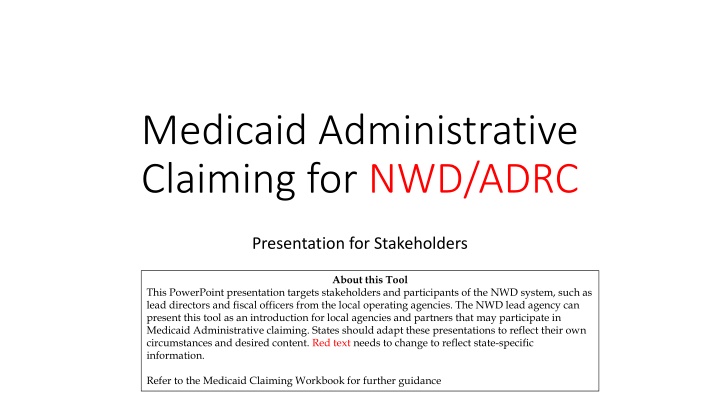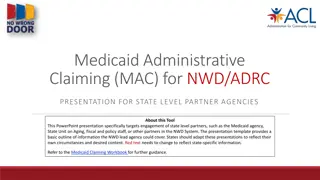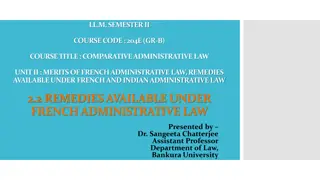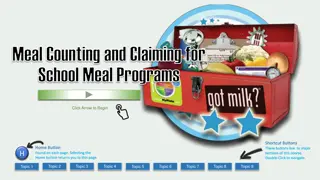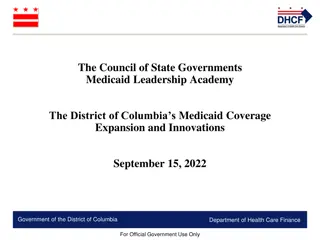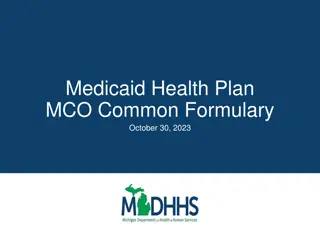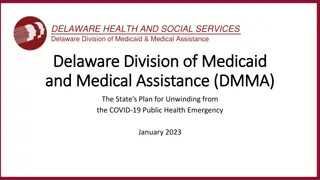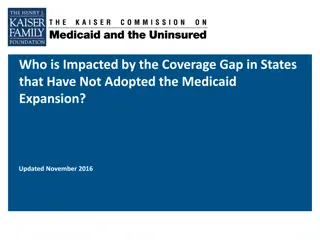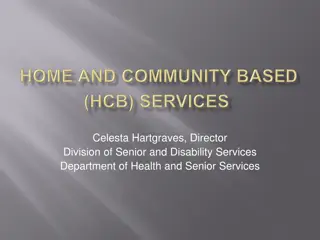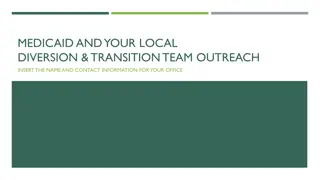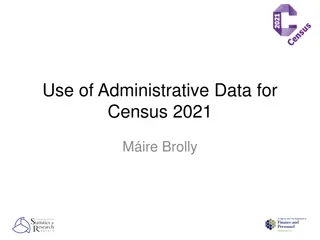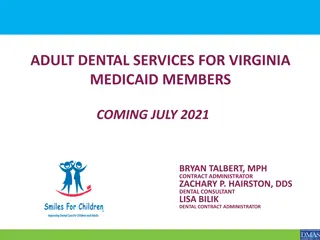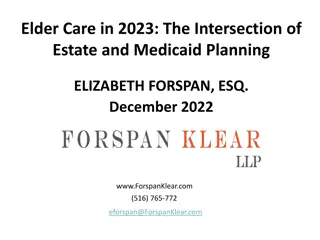Medicaid Administrative Claiming Overview for Stakeholders
This tool is a PowerPoint presentation aimed at stakeholders in the NWD system, providing an introduction to Medicaid Administrative Claiming. It covers the importance of pursuing Administrative Claiming for NWD/ADRC functions, infrastructure, staff time documentation, cost mechanisms, and roles of state and local agencies.
Uploaded on Mar 08, 2025 | 0 Views
Download Presentation

Please find below an Image/Link to download the presentation.
The content on the website is provided AS IS for your information and personal use only. It may not be sold, licensed, or shared on other websites without obtaining consent from the author.If you encounter any issues during the download, it is possible that the publisher has removed the file from their server.
You are allowed to download the files provided on this website for personal or commercial use, subject to the condition that they are used lawfully. All files are the property of their respective owners.
The content on the website is provided AS IS for your information and personal use only. It may not be sold, licensed, or shared on other websites without obtaining consent from the author.
E N D
Presentation Transcript
Medicaid Administrative Claiming for NWD/ADRC Presentation for Stakeholders About this Tool This PowerPoint presentation targets stakeholders and participants of the NWD system, such as lead directors and fiscal officers from the local operating agencies. The NWD lead agency can present this tool as an introduction for local agencies and partners that may participate in Medicaid Administrative claiming. States should adapt these presentations to reflect their own circumstances and desired content. Red text needs to change to reflect state-specific information. Refer to the Medicaid Claiming Workbook for further guidance
Agenda Provide an overview of Administrative Claiming Make the case for pursing Administrative Claiming for NWD/ADRC functions and why it should be pursued Review the Administrative Claiming infrastructure and development process Review the methodology for documenting staff time Discuss the mechanisms for documenting the staff costs Roles and responsibilities of State and local agencies Questions
Medicaid Administrative Claiming Overview Administrative Claiming provides federal financial participation (FFP), generally 50%, to cover activities that contribute to the efficient and effective administration of the Medicaid program Many local agency functions potentially eligible for matching Medicaid administrative funds Administrative claiming can provide an ongoing, sustainable source of funding for enhanced local agency activities Note: It is likely other agencies in your state are already conducting Administrative Claiming and they may be able to provide technical support Slide 4
Medicaid Administrative Claiming for NWD/ADRCs Endorsed by ACL and CMS See: https://www.medicaid.gov/medicaid/financing-and- reimbursement/admin-claiming/no-wrong-door/index.html As of March 2017, in place in a number of states - for an updated list, please visit nwd.acl.gov/resources.html DC Florida Massachusetts Maryland Montana New Hampshire Ohio Oregon Washington Wisconsin Slide 5
Activities Reimbursed Under Administrative Claiming Potential Medicaid related activities include: Outreach and enrollment Case management Provider monitoring Planning and development Training Reporting/program management Network development Auditing Quality improvement Person-Centered Counseling Slide 6
Why Should States Pursue Administrative Claiming? Ongoing source of funding: Once approved, funding will continue Wisconsin claims 38-40% federal dollars* Strengthens the case for State and local funding: Local funding can present challenges if not consistently provided or if state funds are not used to cover parts of the state where local funding is unavailable or insufficient Reinforces local agencies as a core infrastructure supporting the Medicaid program This funding becomes the backbone for securing additional revenue sources: Medicaid Choice Counseling, health plans, private pay, etc. Does not require major changes to regular operations Staff already do the work! *Comments from Julie Schroeder, Wisconsin Department of Health Services, No Wrong Door Learning Session, March 2016 Slide 7
Overview of Administrative Claiming Infrastructure and Development Process Slide 8
Key Components of Administrative Claiming Infrastructure Phase II: Develop Agreements and Approvals Phase I: Assess Readiness and Document Medicaid Time Engage NWD System Lead Agency with a State Medicaid Agency Lead Establish Contractual Agreements Identify Permissible Sources of Non-Federal Funds for Match Secure CMS/DCA Review and Approval Identify Costs of Allowable and Allocable Activities Identify NWD System Activities Potentially Eligible for FFP Slide 9
Administrative Claiming and Reimbursement Process- Once Implemented Operating agency adds all participating staff into "cost pool" State Medicaid agency submits claiming report, receives federal funds, and allocates funds to operating agency for disbursement Operating agency runs time studies to capture staff time Operating agency calculates the percent of Medicaid related time and requests reimbursement from state Medicaid Local sites submit quarterly spreadsheets with actual expenditures to operating agency Slide 10
Development Timeline Develop and Test Time Study 4-6 months State Medicaid Agency submits packet to CMS 1 month MoU between State Medicaid Agency and Operating Agencies 2-3 months Engage NWD Claiming Team with a State Medicaid Agency Lead CMS Approval Develop and populate the Cost Pool 2-3 months Slide 11
Agreements and Approvals Likely Chain of Agreements: Medicaid agency Operating agency CMS Local sites At minimum, MOU between Single State Medicaid agency and operating agency Agreement with CMS will occur via an amendment to the state s Cost Allocation Plan CMS will need to approve the amended plan Slide 12 Slide 12
Documenting Staff Time- Developing the Time Study Codes
Documenting Medicaid Related Time- Time Study Codes Establish codes to classify how staff spend their time: Medicaid related Not Medicaid related General administration Codes should both: Appear similar to what CMS has seen in previous approved applications Make sense to the workers who need to code their time Slide 14
Current NWD/ADRC Operations to be Included in the Codes Codes should reflect operations and tasks of local agency, supervisors, and frontline staff. Current NWD/ADRC Operations to Included in the Codes: Options Counseling/Person Centered Counseling/Information and Assistance Medicaid screening or assessment tool Service coordination for individuals in Medicaid spenddown Care management program targeted to at risk older adults not eligible for Medicaid Program management and training Slide 15
Time Study Methodology A method for calculating the overall percentage of time spent on Medicaid-related activities Potential options: Random moment survey (RMS) collects a sample of staff time by randomly issued brief surveys during the quarter Daily log/timesheet code time for entire day in 15 minute units Alternative time tracking, such as 100% documentation for only a portion of the days State which method the agency is leaning towards? Slide 16
Infrastructure for the Time Study Proposed infrastructure for implementing methodology Conduct RMS using SurveyMonkey for initial pilot then procure contractor/vendor for ongoing time study Establish training and monitoring infrastructure Conduct pilots to: Establish whether code descriptions are clear to local staff Develop estimate of the amount of FFP to claim Test monitoring infrastructure to insure targeted ongoing training needs are detected and provided Slide 17
Establishing Staff Costs- Developing the Cost Pool
Establishing Cost of Staff Time All costs for staff participating in time study on a quarterly basis Costs for support staff that are not participating in the time study (i.e. directors, supervisors, administrators) Align cost categories with OMB guidance and state practices Mechanism for reporting costs (e.g., standardized Excel spreadsheet) Work with local sites to complete reporting mechanism accurately Agency overseeing time study and the Medicaid agency will review reports Slide 19
Identify Relevant Cost Categories Purpose: To identify all costs that support staff time, activities, and operations. 1. Identify and define costs using cost categories similar to State chart of accounts. 2. Develop spreadsheet/invoice using cost categories. 3. Understand what types of costs are disallowed or not agreed upon by Medicaid (e.g. food). 4. Review and pilot test spreadsheet/invoice with local fiscal staff to ensure they understand the process and task categories. Slide 20
Examples of Reimbursable Costs Salaries Fringe and Benefits Indirect Travel Vehicle costs Training Phone/telecom Postage Printing Association dues Software Equipment and maintenance Contractual services (e.g. audit, accounting) Outreach Slide 21
Establishing Cost of Staff Time- Cost Pool Overview Cost pool must capture actual total costs for each worker included in cost pool Each entity will submit quarterly data to the operating agency about the costs associated with staff participating in the time study. Data include: Staff salary/wages Fringe Benefits Travel costs Training and staff development Include costs for staff that support these workers (e.g., Execs, admins, IT administrators, etc.) Operating Agency then aggregates this data using Excel to establish the State Quarterly Claim Quarterly Claim = the requested amount of reimbursement for Medicaid related activities The operating agency applies the Medicaid related time to the quarterly cost data submitted by the local agency. Slide 22
Responsibilities of the Agency Overseeing Administrative Claiming 1. Oversee the development of the claiming infrastructure 2. Run time studies 3. Gather cost spreadsheets 4. Ensure appropriate staff participate in time studies 5. Calculate quarterly reimbursement and provide invoice to Medicaid 6. Disburse reimbursements to local sites 7. Quality assurance and compliance fiscal & program Training, fiscal reviews, time sample reviews Slide 23
Local Agency Responsibilities Ensure all appropriate staff performing reimbursable activities participate in the time study Report and track matching dollars to ensure non-federal dollars allocated to supporting reimbursable tasks and time study staff Review and establish intake and triage workflows Attend trainings and participate in time studies Submit timely fiscal spreadsheets Slide 24
Helpful Hints Talk with other states to learn from their experiences Early collaboration between State and local staff and preliminary mini-pilots can improve the accuracy of codes and need for further refinement Provide thorough training and develop mechanism for answering ongoing questions Set realistic goals for data collection and time study duration Smaller agencies may need more time to gather data Don t over complicate!! Staff already perform tasks; not changing day to day operations Collect complete costs for staff participating in time study (e.g., rent, utilities, etc.) Direct supervisor of staff participating in time study should be a part of the process of adjudicating moments, followed by real-time trainings as needed Slide 25
Questions? Slide 26
Next Steps Do we have enough support to move forward? If not, what will it take to get us there? Who needs to be involved in developing the infrastructure? What is our strategy for approaching the Medicaid agency?
